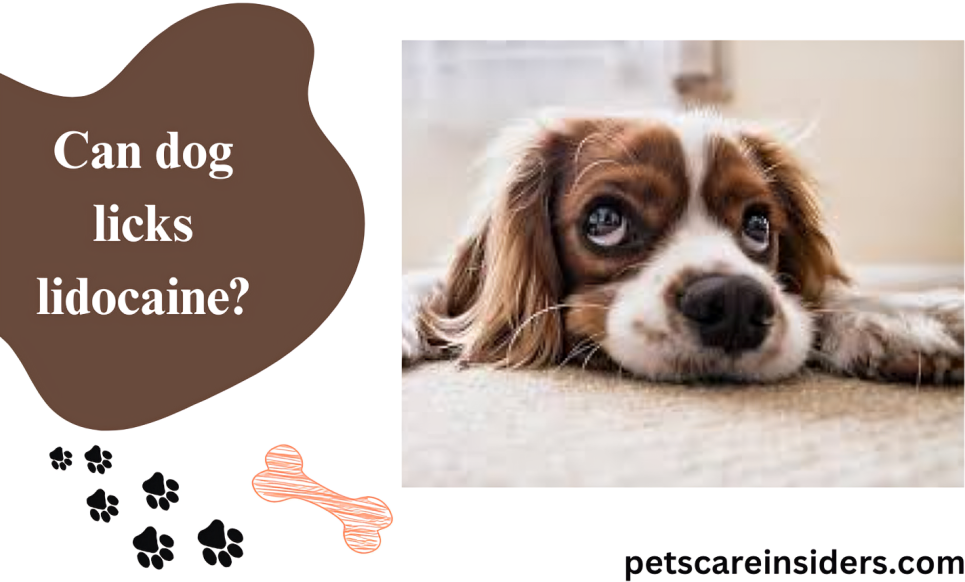Animals and humans alike use lidocaine, a typical local anesthetic, to numb tissues and relieve pain. It briefly relieves discomfort by interfering with nerve signals in the body. Animals can safely utilize lidocaine as prescribed by a veterinarian as long as it is administered as indicated. On the other hand, detrimental health effects may result if a dog licks or ingests lidocaine improperly, such as chewing on a patch or licking a cream. Depending on the manner and quantity of exposure to lidocaine, the effects can differ. You can learn more about dog care.
Immediate Symptoms of dog licks lidocaine
When a dog licks or ingests lidocaine, several immediate symptoms may occur, including:
- Hypersalivation: Excessive drooling is a common immediate reaction to the bitter taste of lidocaine. Dogs may produce more saliva than usual as their body tries to clear the substance from their mouth.
- Vomiting: Vomiting is the body’s normal reaction to consuming something poisonous or annoying. This aids in the stomach’s removal of lidocaine, preventing its absorption into the bloodstream.
- Nausea: Dogs may display discomfort and sickness, such as lip-licking, drooling, or retching. They may also show restlessness or discomfort.
- Behavioral Changes: Dogs may experience anxiety or agitation in response to the unpleasant taste and feeling caused by lidocaine ingestion. They may pace, whine, or seek comfort from their owners.
Local Anesthetic Toxicity
If a dog consumes a larger quantity of lidocaine, they can experience symptoms of local anesthetic toxicity, which may include:
- Nervous System Depression: Dogs may exhibit drowsiness, lethargy, or confusion. Lidocaine can depress the central nervous system, reducing activity and responsiveness.
- Cardiac Effects: Lidocaine toxicity can affect the heart, leading to irregular heart rate (arrhythmias) or, in severe cases, cardiac arrest. Arrhythmias can manifest as a rapid, slow, or irregular rhythm.
- Respiratory Distress: Dogs may experience difficulty breathing or panting. This can occur because of the effects of lidocaine on the respiratory system, which can lead to reduced lung function.
Long-Term Effects
Dogs that swallow lidocaine may experience the following long-term effects, depending on the dosage and length of exposure:
- Organ Damage: Dog owners must understand that lidocaine can damage their pet’s liver and kidneys. These organs are responsible for the body’s chemical metabolization and excretion. High doses or prolonged exposure to lidocaine can cause toxicity in several organs, which can impair function and perhaps result in lifelong damage.
- Neurological Issues: Dogs who consume lidocaine may experience neurological issues. This can involve abnormal movements caused by abnormal brain electrical activity, tremors, seizures, or other abnormalities in movement. Seizures can range widely in severity and occasionally be lethal.
Veterinary Care of dog licks lidocaine
Not only is it essential to act quickly and seek veterinarian care if you fear your dog has licked or consumed lidocaine, but it’s also your obligation. It helps if you respond right away. How should you proceed?
- Immediate Action: Get in touch with an emergency animal clinic or your veterinarian right away. Tell them about your dog’s symptoms, the type of lidocaine (e.g., cream or patch), and the amount of lidocaine eaten (if known).
- Treatment: Depending on the extent of the intake, your veterinarian—the professional in this case—will suggest a few different courses of action.
- Inducing Vomiting: If the ingestion was recent (typically within the last hour or two), your veterinarian may induce vomiting to remove the lidocaine from your dog’s stomach. This helps prevent further absorption into the bloodstream.
- Activated Charcoal Administration: Activated charcoal absorbs any leftover lidocaine in the stomach and intestines, so it can be taken orally to lessen its absorption into the bloodstream.
- Supportive Care: Depending on your dog’s symptoms, your veterinarian will offer supportive care. This could entail vital sign monitoring, medication to prevent vomiting or seizures, and intravenous fluids to keep the patient hydrated.
- Monitoring: Your veterinarian will closely observe your dog, but vigilance is also crucial. Watch for any developing symptoms of lidocaine toxicity, such as neurological issues, cardiac abnormalities, or respiratory distress. Your attention can ensure timely intervention if additional treatments are needed.
Preventing Lidocaine Exposure in Pets
To prevent the accidental exposure of your pet to lidocaine, follow these preventive measures:
- Secure Storage: As a conscientious pet owner, you must safely store any medications, including lidocaine, out of your pet’s reach. Store them on a shelf or in a locked cabinet, so your pet can’t reach them. This covers lidocaine patches, gels, creams, and any other form of the drug.
- Dispose Properly: Safely discard used lidocaine patches or other products according to the manufacturer’s instructions or your veterinarian’s advice. Ensure that they are placed in a sealed container and disposed of to prevent your pet from accessing them.
- Awareness: Be aware of any items containing lidocaine that could be accessible to your pet. This includes being cautious when using lidocaine-containing products around your pet and ensuring they are stored safely after use.
Conclusion
Lidocaine can be beneficial when used correctly, but ingestion by dogs poses serious risks. Immediate symptoms such as hypersalivation and vomiting may occur, with potential long-term effects including organ damage and neurological issues. Prompt veterinary care is crucial to mitigating harm and ensuring your pet’s safety.
